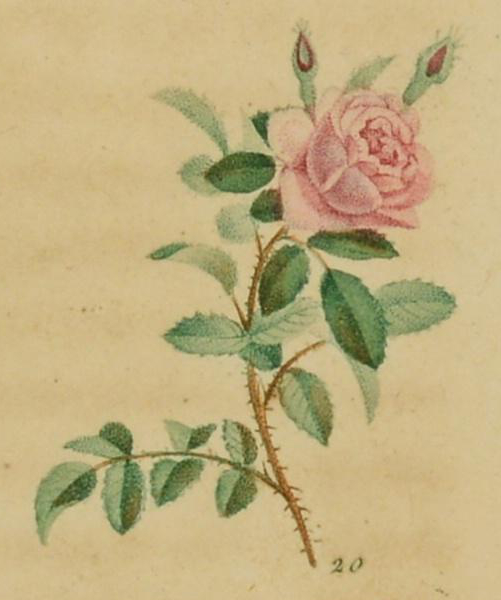This entry is for a full-blown garden rose, or a rose otherwise unspecified. See also Rose (bud).
☙ Rose
Genus Rosa L. (1753), particularly cultivated varieties.WFO
Period English: rose; full-blown rose; full-blown single rose.
Period French: rose f.; FDE DB rose de jardin f. ('garden rose') DB
Period German: Roſe f. B&M
Sentiments:
De Jardin:
🏶︎ Beuté passagèreTemporary beauty ◼︎ (1811). DB
Flower:
🏶︎ Beauty (1825-1850); HP:FE TTA CHW LH S&K HGA:OT
You are beautiful (1834); O&B
Beauty and love (1839); ESP
🏶︎ Genteel, pretty (1841-1845). LH S&K
Single flower:
🏶︎ Simplicity (1825-1836). HP:FE TTA
Bush:
🏶︎ TBC ◼︎ (1819). CLT
Leaves:
🏶︎ Do not importune (1834); O&B
I never importune (1845). S&K
Full-blown placed over two buds:
🏶︎ Secrecy (1836). TTA
Bouquet of full-blown:
🏶︎ Gratitude (1834). O&B
Garland:
🏶︎ Reward of virtue (1839-1845). ESP S&K
Crown of:
🏶︎ Reward of virtue (1825-1836); HP:FE TTA
🏶︎ Superior merit (1834); O&B
Reward of merit (1841-1845). LH S&K
Withered:
🏶︎ Reproach (1834); O&B
🏶︎ Fleeting beauty (1839). ESP
See also White rose (dried).
Heraldry:
Flower:
England. ESP
Hips:
Clan MacNab. HP:FE
Region: TBC.
Seasonality: TBC.
Period Colours: TBC.
Varieties and Species:
I have listed all current and future entries for roses for which I have identified the variety or species below for the reader's ease of navigation. Sentiments applied to these separate entries should be considered in substitute of those of a generic rose, rather than an appellation.
Rosa × alba L. (1753), WFO White rose of York;
Rosa × alba var. incarnata (Mill.) Weston (pre-1597), HMF Maiden's blush rose;
Rosa canina L. (1753), WFO Dog rose, briar rose or wild rose;
Rosa carolina L. (1753), WFO Carolina rose;
Rosa × centifolia L. (1753),WFO Cabbage rose, period 'hundred-leaved rose';
Rosa × centifolia 'Unique Blanche',HMF Unique rose;
Rosa × centifolia f. muscosa (Aiton) C.K.Schneid. (1905),WFO Moss rose;
Rosa × centifolia var. parvifolia (Ehrh.) Rehder (1916),WFO HMF Burgundy rose;
Rosa chinensis var. semperflorens (W M Curtis) Koehne (1893), HMF Slater's crimson china, period 'China rose', 'Chinese Damask rose' or 'Chinese dark rose';
Rosa × damascena Herrm. (1762), WFO Damask rose;
Rosa × damascena 'Quatre Saisons' (pre-1633), HMF Monthly rose;
Rosa foetida Herrm. (1762), WFO Austrian briar, period 'yellow rose';
Rosa foetida 'bicolor' (pre-1590), HMF Austrian rose;
Rosa gallica var. officinalis Ser. 'Versicolor', HMF Mundi rose;
Rosa gallica var. versicolor L., HMF Variegated rose, period 'York and Lancaster rose';
Rosa glauca Pourr. (1788) WFO (exhibition name R. rubrifolia), Red-leaved rose;
Rosa majalis Herrm. (1762), WFO Cinnamon rose, period 'May rose';
Rosa moschata Herrm. (1762), WFO Musk rose;
Rosa multiflora Thunb. (1784),WFO Multiflora rose;
Rosa pendulina L. (1753), WFO HMF Alpine rose, period 'thornless rose'.
For the Victorians' 'Bridal rose', see Roseleaf bramble.
For the Victorians' 'Christmas rose', see Hellebore.
For the Victorians' 'guelder rose', see Guelder-rose.
For the Victorians' 'Japan rose', see Camellia.
A chapeau of roses is a lover's treasure in Le Roman de Perceforest (c.1340). CLT
A rose wet with tears is used by Oriane to tell Amadis of her captivity in Amadís de Gaula (pre-1508). CLT
In Fabre d'Églantine's 1793 rural emblem annex to the French Republican calendar, Rose is the emblem of 1 Floréal (20 April).
❗︎ Be cautious of fabricated parables when approaching the below entries, especially regarding cultures that may have appeared "exotic" to the writers in Western Europe. Stories about flower symbolism in "Turkish tradition" reported in this period are largely fabricated as part of an Orientalist fad, and have little root in reality.
❗︎ Similarly, be cautious in believing without question the words of poets. Note La Tour's relay of a story of Persian poet Saadi Shīrāzī offering a rose to the Frankish crusader who allegedly held him captive to urge him to break his chains; this is now considered an invention of the poet.
Abécédaire de Flore
◼︎ B. Delachénaye, 1811
SUITE DES NOMS DE FLEURS
SUBSTITUÉES AUX LETTRES ALPHABÉTIQUES.
| NOM DES FLEURS. | MOTS ANALOGUES. |
| 20. rose. | j'ose, compose, chose. |
(22)
20. De la rose.
La première [rose] exprimera tous les ô longs, et tous ceux qui servent à former les nasales et les voyelles composées, comme il ose, alose, leçon, pigeon, vous, nous, etc.
(43)

Plate 2: Figure 20, Rosa × centifolia L. (1753).
DESCRIPTION DES PLANTES
DE L’ABÉCÉDAIRE DE FLORE.
DEUXIÈME PLANCHE.
(82)
EMBLÉMES TIRÉS DU RÈGNE VÉGÉTAL.
R.
| Rose blanche | signifie | innocence. |
| —— blanche desséchée | plutôt mourir que de perdre l'innocence. | |
| —— capucine | étude. | |
| —— de jardin | beuté passagère. | |
| —— en bouton | cœur qui ignore l'amour. | |
| —— jaune | infidélité. | |
| Rose musquée | signifie | caprice. |
| —— panachée | été. | |
| —— sans épine | amie sincère. | |
| —— sauvage | simplicité |
(153-154)